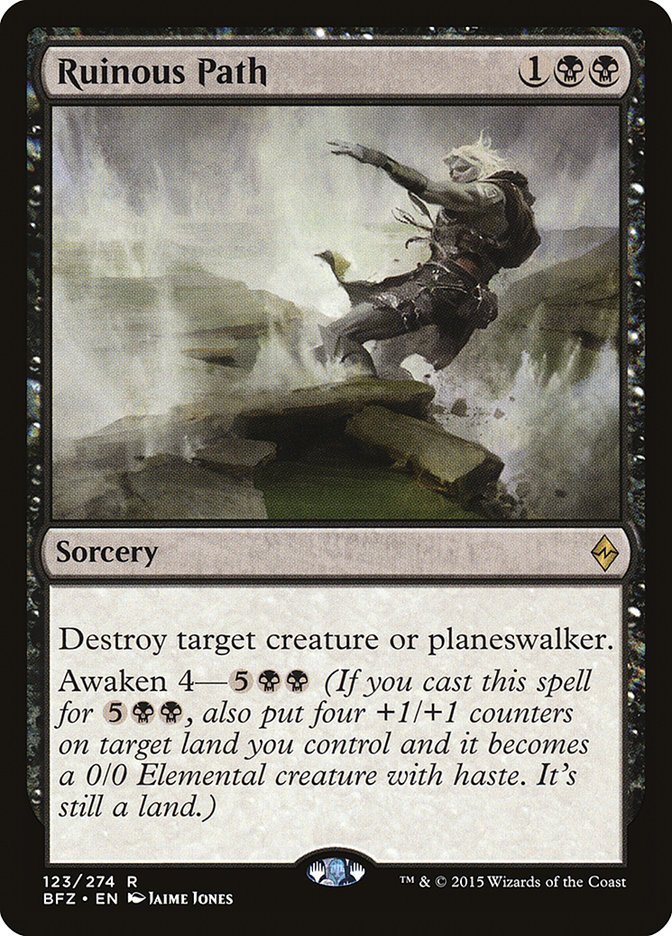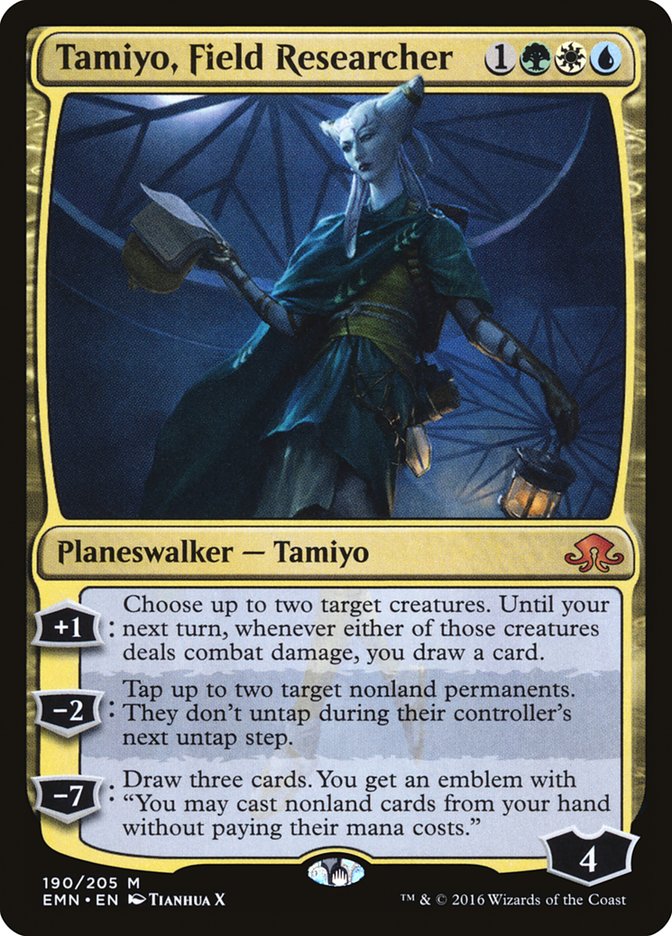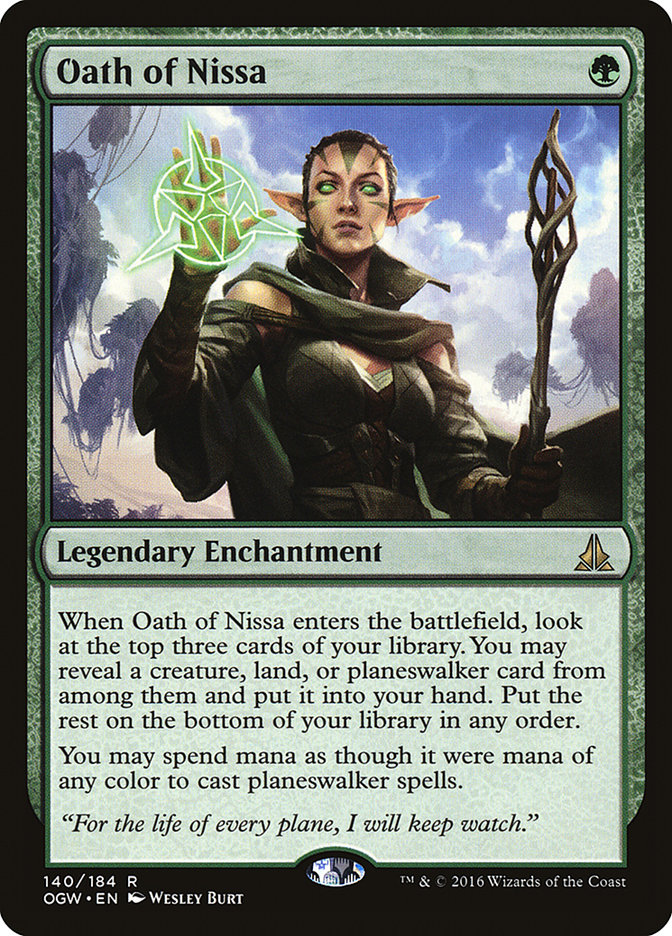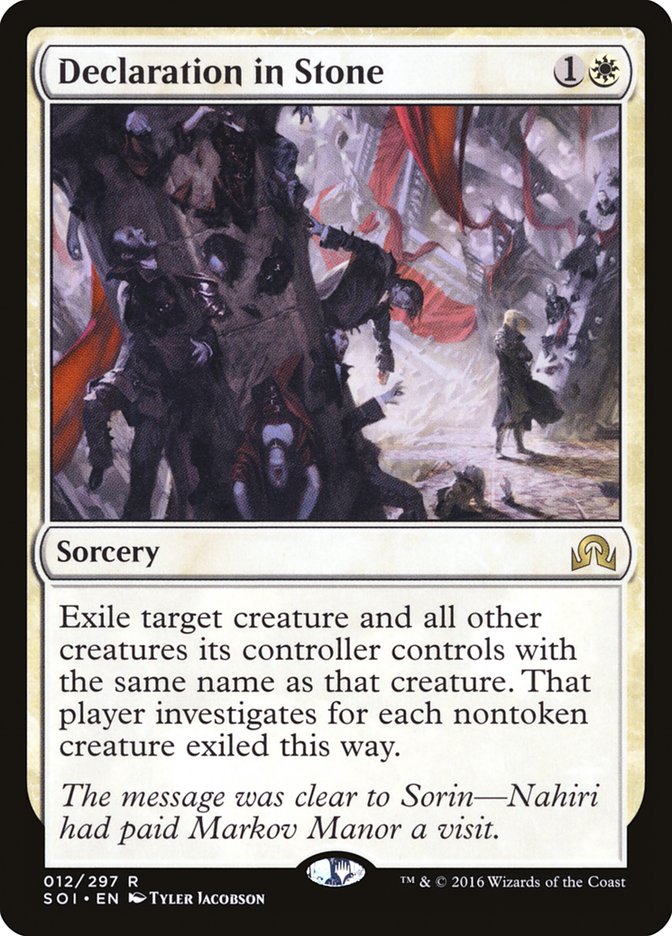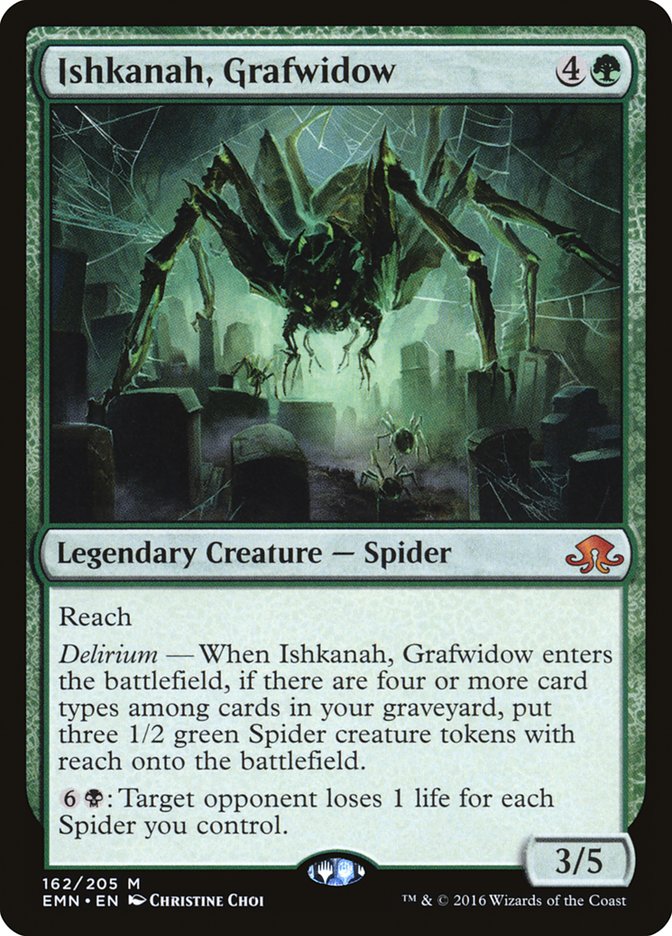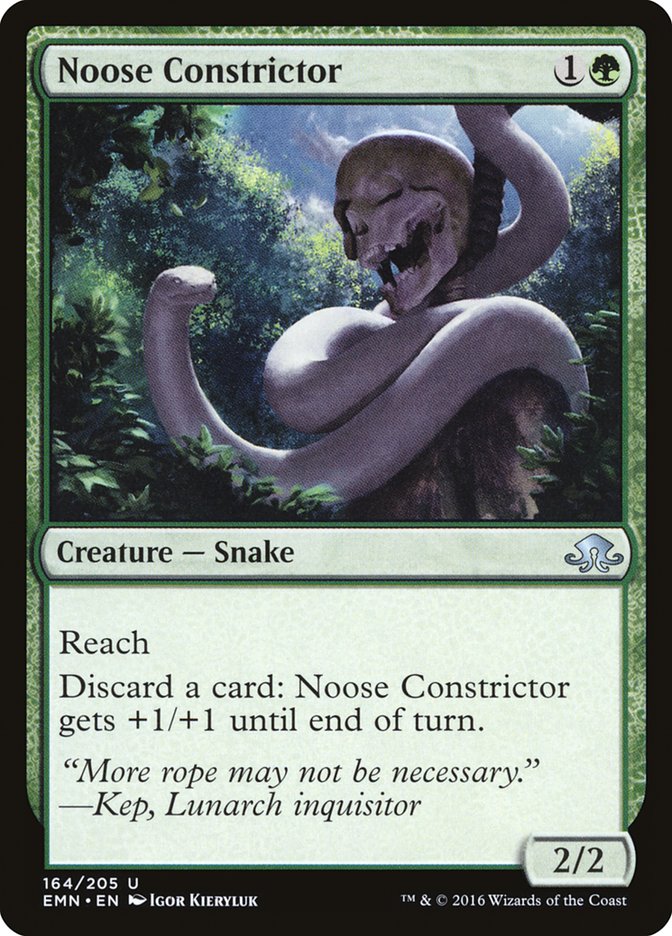I love going out to eat. I probably eat a little bit too much and a little too unhealthily because of how frequently I will go with friends to restaurants as opposed to staying in and eating. I somewhat offset the heightened cost of eating out so regularly by turning it into a more social outing than a good number of restaurant patrons.
One of the best ways to keep things social and mix things up is by having the table just share a flurry of different appetizers in lieu of separate individual dishes. This way everybody gets to try a few different things and there tend to be more leftovers that make their way home than on the typical trip to Chili’s or TGI Friday’s.
This article mirrors the idea of replacing a single article centered around a main theme with a handful of miniature articles that aren’t quite good enough for a full portion, but just right when coupled with other tasty, deep-fried (and guilt-free) ideas.
The Value in Planeswalkers
Planeswalkers are some of the hardest cards in Magic to evaluate. Every time a new set comes out, people spend half of spoiler season discussing whether or not specific planeswalkers will have a significant impact in Standard. Outside of my having the privilege of spoiling Tamiyo, Field Researcher, the spoiler-related Tweet with the most interaction on my Twitter was one about Liliana, the Last Hope by a pretty fair margin:
I may be alone in this, but I think that the new Liliana is very good.
— Emma Handy (@Em_TeeGee) July 4, 2016
A lot of the trouble in understanding planeswalkers’ power levels comes from their value being directly proportionate to how long they’re on the battlefield. This leads to a direct correlation in planeswalkers being powerful and how well they are able to protect themselves.
Last weekend in at #SCGBALT I audibled to G/W Tokens at the last second and, despite having a poor Day 1 performance, felt great about the deck choice:
Creatures (16)
Planeswalkers (8)
Lands (25)
Spells (11)

At this point I feel like I’m beating a dead horse in explaining that G/W Tokens is a good deck after the relative dominance of the deck pre-Eldritch Moon, but stay with me.
The success of G/W Tokens is directly proportionate to how well it can protect and utilize Gideon, Ally of Zendikar in most matchups. This is due to Gideon’s ability to play so many different roles against different archetypes. Against control decks, Gideon is a 5/5 indestructible creature for 2WW. Against more aggressive strategies, Gideon serves as a Bitterblossom-meets-Fog-combination. In battles of attrition or long slogs that involve significant amounts of combat math, Gideon can create a Glorious Anthem-esque trump that is nigh-impossible to deal with (without just killing all of Gideon’s owner’s creatures).
Most of the deck is centered built around keeping Gideon, Ally of Zendikar on the battlefield as long as possible in order to take advantage of these abilities in a way that is disproportionately powerful for a four-mana Magic card.
This idea can be translated to other decks and even in-game when making a tough decision on whether to cast a planeswalker or another similarly styled threat.
Creatures (31)
- 4 Knight of the White Orchid
- 4 Dragon Hunter
- 3 Kytheon, Hero of Akros
- 2 Archangel of Tithes
- 4 Consul's Lieutenant
- 3 Expedition Envoy
- 3 Reflector Mage
- 4 Thraben Inspector
- 4 Thalia's Lieutenant
Lands (22)
Spells (7)

Earlier this year at the #SCGINVI, I was faced with a situation while piloting W/U Humans. It was hard to decide whether it was better to cast Archangel of Tithes or Gideon, Ally of Zendikar during Game 3 against a W/B Control deck. During the game, I decided that both threats had a similar floor (that’s to say, they die instantly to Ruinous Path), but Gideon, Ally of Zendikar would generate more advantage the more turns that he was on the battlefield.
Several turns later, the pair of Knight Ally tokens that Gideon, Ally of Zendikar created before hitting the graveyard ended up doing enough collateral damage to finish the opponent off after slogging through a near-endless stream of removal. It’s hard to say if the game would’ve broken down the same way if I had led with the Archangel of Tithes and not had the extra turn to make a Knight Ally token between when the opponent had drawn a copy of Ruinous Path and when I cast Gideon, Ally of Zendikar.
Ideas like these are what lead to the power of planeswalkers being so hard to understand within the context of the formats they’re being played in. Tamiyo, Field Researcher may look like a great Magic card, but what if she only gets to use her +1 once before she dies? Is she still good? (Yes.)
[Don’t] Hold the Door
Understanding what is important in a game of Magic is hard. One of the aspects of my Magic game I take a decent amount of pride in is evaluating complex battlefields or game-states and understanding what is important within the game itself. This doesn’t always manifest itself in something tangible or even a card. A lot of times, the most important thing in a game of Magic is killing the opponent.
A common phrase for putting a game out of reach for the opponent or getting a game to the point in which winning is academic is called “closing the door.” It’s more important than a lot of people think.
To continue with using G/W Tokens as an example, Gideon, Ally of Zendikar’s +1 is an example of an ability that can turn the dynamic of a game on its head when it’s time for his controller to become the aggressor. Last weekend, the game I lost kept me out of Day 2 was ultimately decided during a turn in which I had had to make a choice based on whether I was trying to gain value off Gideon, Ally of Zendikar or close the game.
In the situation I had four three-power creatures; an Archangel Avacyn; a Gideon, Ally of Zendikar at one loyalty; a Gideon, Ally of Zendikar Emblem; and twenty life to my opponent’s six lands, double Sylvan Advocate, and eighteen life. The opponent had revealed Archangel Avacyn with their Oath of Nissa the previous turn and my only card in hand was Declaration in Stone.
When describing the situation in hindsight, it is relatively clear that the proper play was to use Declaration in Stone on the opponent’s Sylvan Advocates; tick up Gideon, Ally of Zendikar; and crash in with the team. The opponent would then flash in Archangel Avacyn, block the largest creature (Gideon) in order to not die, go to one life, and die on my following turn.
At the time I was too focused on protecting Gideon, Ally of Zendikar and keeping him alive in what was effectively a mirror match (the opponent was on Naya Tokens) due to Gideon’s importance in the matchup. It was hard to think of anything other than keeping Gideon alive, and in my head, a single removal spell meant that Archangel Avacyn would block my Avacyn, the opponent would use a removal spell on my Avacyn, and then their Archangel Avacyn could finish off Gideon.
It’s easy to get sidetracked in these kinds of situations due to the life total’s simultaneous importance and irrelevance in any given game of Magic. It doesn’t matter how much damage is done to an opponent as long as their life total is above zero; on the other hand, if one’s life total reaches zero, nothing else in the game matters (outside of weird Phyrexian Unlife-related games).
Identifying what roles specific cards play within a matchup is incredibly important, but identifying pockets of opportunity to put the opponent in an unwinnable position is in integral part of Magic that isn’t talked about nearly enough. Learn to find these pockets and you won’t find yourself searching the internet for references to a show you don’t watch for the sake of a punchline.
Overload Overload Overload
Some cards really can’t be played around and it’s foolish to try. There was a time, when Abrupt Decay was the new kid on the block in Legacy, that Miracles began playing awkward cards in the vein of Misdirection in order to combat the uncounterable instant. Another strategy that was later adopted was cutting Counterbalances in order to minimize the impact that Abrupt Decay could have on a single game.
Since then more streamlined and aggressive forms of Miracles have tended to take the approach of overloading the opponent’s Abrupt Decays:
Creatures (5)
Planeswalkers (3)
Lands (21)
Spells (31)

Between Counterbalance, Monastery Mentor, and Back to Basics, the various Abrupt Decay decks tend to have trouble having enough removal spells for the Miracles sideboard plan. This same ideology is what led to Osyp Lebedowicz to success at last weekend’s Standard Open in Baltimore:
Creatures (12)
Planeswalkers (8)
Lands (25)
Spells (15)

When Spell Queller and Bant Company first rose to power at #SCGCOL, it was hard not to be skeptical that the Voice and Ally of Zendikar would each have trouble dealing with the handful of flying threats that Bant Company is wont to deploy. Having a Gideon, Ally of Zendikar exiled by an opposing Spell Queller is rather embarrassing in and of itself.
For Eric Rill, it seemed the best solution to dealing with Bant Company was including Ishkanah, Grafwidow and ways to enable its delirium more easily via Evolving Wilds.
Creatures (16)
Planeswalkers (8)
Lands (25)
Spells (11)

Due to my infatuation with the G/W Tokens archetype,* it was easy to find myself registering a list very similar to Eric’s last weekend without fulling exploring all of the options available to me.
*Seriously, have you ever had the opportunity to point to Gideon, Ally of Zendikar and Nissa, Voice of Zendikar simultaneously and say “Tokens” before passing the turn? I can’t think of the last time I’ve felt like something so minuscule felt so commanding in a Standard format.
Osyp’s list took an incredibly interesting approach to Spell Queller. The three copies of Tragic Arrogance in the maindeck signal that the card is an integral part of the deck’s gameplan and there is a plan to utilize the card. It isn’t so apparent on paper, but rather than trying to use a card like Ishkanah, Grafwidow to gum up the battlefield and outclass Spell Quellers there, Osyp elected to accept what Spell Queller was going to do.
Rather than try to play around Spell Queller and try to reduce the value of a card with such broad applications, Osyp elected to create a gameplan in which it was anticipated for a spell (or two or three) would get exiled by Eldritch Moon‘s most irritating Spirit.
From here Osyp has a sweeper (Tragic Arrogance) that cleans up the mess that he seemingly “walked into” that can’t be countered by Selfless Spirit and ignores Thalia, Heretic Cathar. After Tragic Arrogance resolves, Spell Queller will return any spell(s) to the stack (and hopefully the battlefield after they resolve) with the Queller’s controller having a near-empty battlefield. It’s a great way to resolve a copy of Gideon or Nissa at a point when the advantages they produce can really snowball into something bigger. The elegance of the plan is breathtaking and it shows a real understanding of how the G/W Tokens – Bant Company matchup tends to play out.
Spell Queller Isn’t Unbeatable
Seriously, Spell Queller is a great card, but it isn’t the only great card. Osyp Lebedowicz was able to construct a gameplan that made the card relatively embarrassing. Many of the numbers that Bant Company is putting up are scary, but a lot of the reason that it is being represented in such high numbers is that people haven’t had the ability to try out new things.
In this week’s SCG Newsletter, I talk a little bit about Cory Dissinger’s incredibly exciting approach to besting the Bant Company deck:
Creatures (18)
- 1 Elvish Visionary
- 4 Den Protector
- 2 Jace, Vryn's Prodigy
- 2 Nissa, Vastwood Seer
- 1 Bounding Krasis
- 1 Hangarback Walker
- 1 Void Grafter
- 1 Emrakul, the Promised End
- 1 Ishkanah, Grafwidow
- 4 Noose Constrictor
Planeswalkers (2)
Lands (25)
Spells (15)

To summarize it, Bant Company can’t present a reasonable enough clock to finish this deck off before it assembles its “combo” of Crush of Tentacles, Den Protector, and ten lands. This allows the deck to repeat the following loop every turn:
1. Cast Den Protector face down for three mana
2. Megamorph Den Protector for 1G and return Crush of Tentacles to owner’s hand.
3. Cast Crush of Tentacles for its surge cost, returning every nonland thing on the battlefield (including Den Protector) to their owners’ hands.
For any decks that don’t play flash creatures, it is an unwinnable position. In theory, this gives the deck enough time to accrue other bits of advantage through multiple Den Protectors or Nissa, Vastwood Seer.
The deck uses cards that either match up well against Spell Queller in Noose Constrictor and Jace, Vryn’s Prodigy; cards that can be cast at varying times and aren’t game-breaking if exiled (see: Oath of Nissa, Nissa, Vastwood Seer); or cards that completely invalidate the impact that a mere 2/3 with flying would have on the game, like Ishkanah, Grafwidow or the aforementioned loop. (Remember the Octopus that Crush of Tentacles leaves behind! It’s no joke.)
If there’s anything that may be required for the future of this deck, it’s a clean answer to Archangel Avacyn. Past that, it is hard to imagine this deck being completely cold to any single aspect of today’s Standard format. It’s hard to say if this deck will end up being a major role-player once Pro Tour Eldritch Moon shakes up what we’ve seen so far, but it is a shining example of a fantastic mental exercise in exploiting a loophole in a format with a single deck occupying nearly 50% of a given metagame.
Wrap-Up
I hope that everyone enjoyed their Magic sampler today and will be coming back and joining us in the future. Make sure and fill out a comment card below, and if you’re a frequent customer, make sure to join our customer reward program. We’ve just added a bunch of new flavors to our “Premium” menu. Oh, and remember, please tip your waitress.


